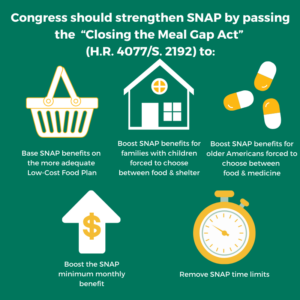November 17, 2021
Dive Into The Data
Watch this webinar to learn from Elaine Waxman about Supplemental Nutrition Assistance Program (SNAP) benefit adequacy and how you can use the Urban Institute’s interactive tool to see if SNAP covers the cost of a meal in your county. Also during the webinar, FRAC will outline actions that can be taken to address hunger cliffs during and after COVID-19.
SNAP benefits are a lifeline for many struggling Americans, but even with the recent improvement in how SNAP benefits are calculated, the maximum allotments still fall short of the amounts needed to afford moderately priced meals in many U.S. counties. According to an updated analytical and interactive tool from the Urban Institute,
- On average, for counties with gaps, the maximum SNAP benefit falls short of an average modestly priced meal by $0.23 (10 percent higher than the maximum benefit level). Rural areas with gaps have a $0.27 shortfall (a 12 percent gap).
- A separate temporary 15 percent boost in SNAP benefits that started in January 2021 was allowed to sunset after September when the statutory authorization ended.
Temporary boosts to SNAP during COVID-19 have helped narrow affordability gaps because most SNAP households received maximum allotments, which normally would only have gone to the nearly 4 in 10 SNAP households with the lowest income levels. Since April 2021, maximum allotment households in many states also have received an extra $95 per month in SNAP Emergency Allotments (EAs).
What Happens When Emergency Declarations End?
As of mid-November 2021, 40 states, Washington, D.C., Guam, and the U.S. Virgin Islands have been approved to continue EAs for all SNAP households. The statutory authority for those issuances, however, will end when pandemic-related health emergency declarations end.
At that point, unless Congress takes action, all SNAP households will revert to traditional program calculations. On average, SNAP households in the formerly EA states will lose $82 per month in SNAP benefits. For those who qualify for the minimum SNAP benefits, their monthly allotments will plunge from $250 to a mere $20.
A worsening hunger cliff looms unless policymakers take action. According to Propel’s October 2021 survey of a sample of its 5 million SNAP customers,
- More than half think the money they have on hand will only last one to two days.
- Unemployment insurance and rental assistance are missing for most of these households.
- Since July 2021, many have benefitted from receipt of the Child Tax Credit (CTC), but CTC payments are slated to end after December 2021.
Close the Meal Gap Bill

One measure that would improve SNAP households’ purchasing power is the Close the Meal Gap bill (H.R. 4077/S.2192), sponsored in the House by Representative Alma Adams (D-NC) and 92 representatives and in the Senate by Senator Kirsten Gillibrand (D-NY) and four senators. The bill would base SNAP benefits on a more adequate food market basket and ease impossible choices families with children are forced to make between paying for food and shelter and that older Americans and people with disabilities must make between paying for food and medicine.
Get Involved With FRAC’s Action Network
Urge Members of Congress to close the SNAP meal gap by sponsoring and enacting H.R. 4077/S.2192. Send an email or share a social media post using FRAC’s Action Network.


